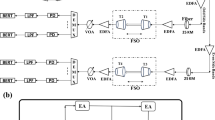Abstract
An M-ary coded synchronous optical code-division multiple-access (O-CDMA) system with pulse-position modulation (PPM) is investigated. One novel class of optical spreading codes based on combinatorial designs is adopted in the multiplexing process. Their ideal correlation properties facilitate the discrimination between desired signals and jamming. However, the multiple-access interference (MAI) with high intensity significantly deteriorates the system performance even if the number of interferers is small. In this paper, we present an interference reduction technique for direct-detection O-CDMA to suppress the noise effect and increase the system capacity. The MAI from reference signals can be estimated by utilizing the uniform cross-correlation (CC) among its sequences and considerably cancelled out after the photodetection process. The upper bound on the error probability of optical synchronous PPM-CDMA is then derived. The proposed system is shown to be effective to improve the bit error performance and to alleviate the error floor when the number of simultaneous users and the received optical power are not appreciably small.
Similar content being viewed by others
References
Salehi J.A.: Code division multiple-access techniques in optical fibre networks - part I: fundamental principles. IEEE Trans. Commun. 37(8), 824–833 (1989)
Karafolas N., Uttamchandani D.: Optical fiber code division multiple access networks: a review. Opt. Fiber Technol. 2(2), 149–168 (1996)
Heritage J.P., Weiner A.M.: Advances in spectral optical code-division multiple-access communications. IEEE J. Sel. Top. Quantum Electron. 13(5), 1351–1369 (2007)
Stok A., Sargent E.H.: The role of optical CDMA in access networks. IEEE Commun. Mag. 40(9), 83–87 (2002)
Kwong W.C., Perrier P.A., Prucnal P.R.: Performance comparison of asynchronous and synchronous code-division multiple-access techniques for fiber-optical local area networks. IEEE Trans. Commun. 39(11), 1625–1634 (1991)
Shalaby H.M.H.: Cochannel interference reduction in optical synchronous PPM-CDMA systems. IEEE Trans. Commun. 46(6), 799–805 (1998)
Lee T.S., Shalaby H.M.H., Ghafouri-Shiraz H.: Estimation and cancellation of multi-user interference in synchronous fiber-optic PPM-CDMA system using Manchester coding. Opt. Laser Technol. 33(8), 573–580 (2001)
Cui K., Leeson M.S., Hines E.L.: Unipolar codes for optical spectral-amplitude code-division multiple-access systems based on combinatorial designs. IET Commun. 3(4), 677–683 (2009)
Cui K., Leeson M.S., Hines E.L.: Performance enhancement of spectral-amplitude OCDMA using novel PPM signaling. Eur. Trans. Telecommun. 20(6), 572–579 (2009)
Shalaby H.M.H.: Performance analysis of optical synchronous CDMA communication systems with PPM signaling. IEEE Trans. Commun. 43(2), 624–634 (1995)
Andersen I.: Combinatorial Designs: Construction Methods. Wiley, New York (1990)
Djordjevic I.B., Vasic B.: Novel combinatorial constructions of optical orthogonal codes for incoherent optical CDMA systems. J. Lightwave Technol. 21(9), 1869–1875 (2003)
Mendez A.J., Gagliardi R.M., Feng H.X.C., Heritage J.P., Morookian J.M.: Strategies for realizing optical CDMA for dense, high-speed, long span, optical network applications. J. Lightwave Technol. 18(12), 1685–1696 (2000)
Author information
Authors and Affiliations
Corresponding author
Rights and permissions
About this article
Cite this article
Cui, K., Leeson, M.S. & Hines, E.L. Direct-detection synchronous O-CDMA system with interference estimation and cancellation. Photon Netw Commun 19, 277–283 (2010). https://doi.org/10.1007/s11107-009-0232-8
Received:
Accepted:
Published:
Issue Date:
DOI: https://doi.org/10.1007/s11107-009-0232-8




